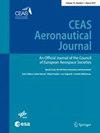飞行数据兼容性检查的实际示例
Q2 Engineering
引用次数: 0
摘要
摘要飞机速度、高度和气流角的准确信息是评估飞机性能和操纵质量的必要条件。这些数量是由通常位于飞机驾驶舱附近的传感器测量的空气数据确定的。由于这些传感器受到机身周围扭曲流场的影响,因此必须进行校正。在首次飞行之前,通常通过风洞实验或CFD计算确定一组校准参数。然而,数据兼容性检查(DCC)方法允许在认证飞行测试期间更准确的空气数据传感器校准。该方法根据惯性加速度、角速度测量值和飞行轨迹重建空气数据量。通过将重建量与实测量进行比较,可以识别大气数据传感器模型的结构和参数。本文介绍了在某飞行试验中用于系统辨识的数据兼容性检验方法和设置。DCC应用于新DLR研究飞机达索猎鹰2000LX ISTAR的测试活动中收集的数据。本文将介绍在大型侧滑机动过程中校准前臂气流叶片和校正传感器的用例。本文章由计算机程序翻译,如有差异,请以英文原文为准。
Practical examples for the flight data compatibility check
Abstract Accurate information about aircraft speed, altitude, and aerodynamic flow angles is essential for evaluating aircraft performance and handling qualities. These quantities are determined from air data measurements taken by sensors normally located near the aircraft cockpit. Since these sensors are affected by the distorted flow field around the fuselage, a correction must be applied. Before the first flight, a set of calibration parameters is usually determined from wind tunnel experiments or CFD calculations. However, the Data Compatibility Check (DCC) method allows a more accurate air data sensor calibration during the certification flight test. This method reconstructs air data quantities from inertial acceleration, angular rate measurements and the flight path. By comparing the reconstructed quantities with the measured ones, the structure and parameters of air data sensor models can be identified. In this paper, an introduction to the data compatibility check method and the setup used in a flight test for system identification is given. The DCC is applied on data gathered from a test campaign with the new DLR research aircraft Dassault Falcon 2000LX ISTAR. Use cases for the calibration of the nose boom airflow vanes and the correction of sensors during large sideslip maneuvers will be presented in this paper.
求助全文
通过发布文献求助,成功后即可免费获取论文全文。
去求助
来源期刊

CEAS Aeronautical Journal
Engineering-Aerospace Engineering
CiteScore
3.40
自引率
0.00%
发文量
53
期刊介绍:
The CEAS Aeronautical Journal has been created under the umbrella of CEAS to provide an appropriate platform for excellent scientific publications submitted by scientists and engineers. The German Aerospace Center (DLR) and the European Space Agency (ESA) support the Journal.The Journal is devoted to publishing results and findings in all areas of aeronautics-related science and technology as well as reports on new developments in design and manufacturing of aircraft, rotorcraft, and unmanned aerial vehicles. Of interest are also (invited) in-depth reviews of the status of development in specific areas of relevance to aeronautics, and descriptions of the potential way forward. Typical disciplines of interest include flight physics and aerodynamics, aeroelasticity and structural mechanics, aeroacoustics, structures and materials, flight mechanics and flight control, systems, flight guidance, air traffic management, communication, navigation and surveillance, aircraft and aircraft design, rotorcraft and propulsion.The Journal publishes peer-reviewed original articles, (invited) reviews and short communications.
 求助内容:
求助内容: 应助结果提醒方式:
应助结果提醒方式:


